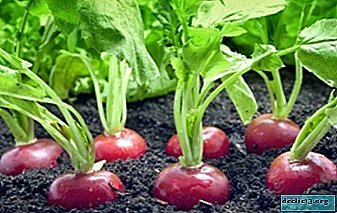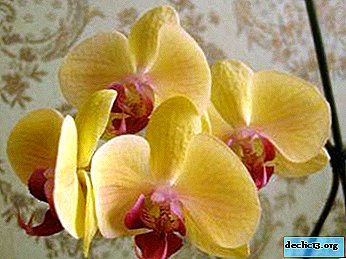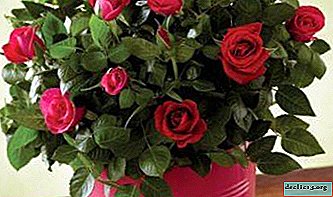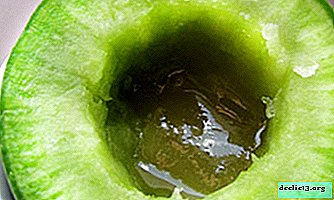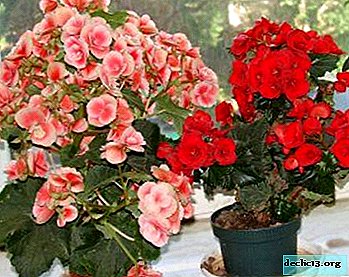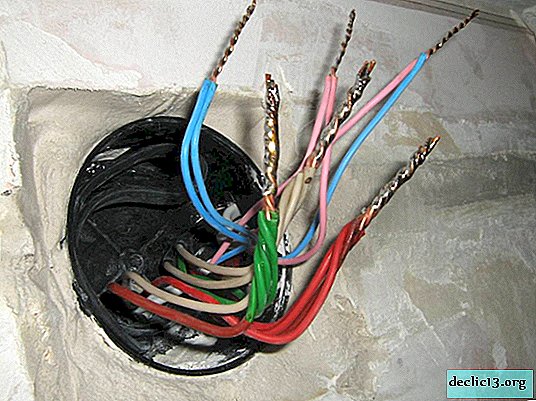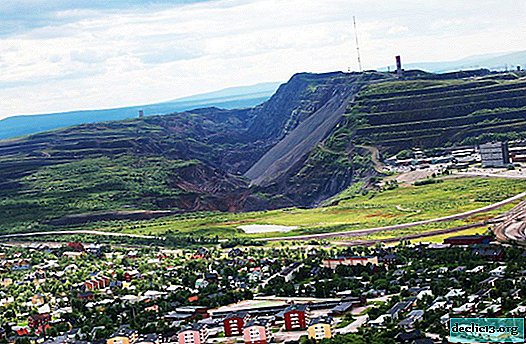Kaiser Wilhelm and Friedrich - varieties of the amazingly beautiful flower of Gloxinia: reproduction, planting, care
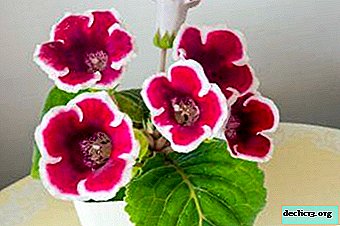
Love at first sight ... This is the meaning attributed to gloxinia in a floral language. And this is no coincidence.
After all, this flower really attracts the attention of gardeners and lovers instantly.
Today we will describe the features of the appearance of Kaiser gloxinia, and also consider in detail the nuances of caring for it, methods of reproduction and what diseases it is susceptible to.
Botanical Description and History
This is a perennial tuberous plant belonging to the geranium family. The bush does not take up much space - upwards it grows to 25 centimeters. It has repeated flowering, that is, after the old buds wither, new ones bloom. This continues from spring to autumn. In the open state, the flower reaches a diameter of 7-8 centimeters. On one plant can dissolve up to 20 buds at a time. The inflorescence consists of five petals.
Leaf plates, which have a fluffy surface and wavy edges, are attached to small cuttings. Each leaf is quite large and reaches a length of up to twenty centimeters. The leaves seem to be surrounded by gorgeous flowers located on relatively short peduncles. All this creates a magnificent decorative composition.
This plant was first discovered and described in the colorful Latin America. during a marine expedition by the young amateur botanist Benjamin Gloxin in the late 18th century. Further propagation of this flower occurred in greenhouses.
Reference! Gloxinia received the second name - Sinningia, which is currently used with the first on a par.Appearance and some features
It is divided into two varieties:
- gloxinia kaiser wilhelm;
- gloxinia kaiser friedrich.
Both types of compact indoor culture. It is very difficult to look away from their deep saturated shades. The first species is characterized by a deep "night" color - dark purple. And the second is distinguished by tenderness - its flowers are painted in raspberry. The petals of both plants are trimmed around the edges with a delicate border of white, and the leaf plates have a dark green color with emerald overflow.
All these properties as a whole do not allow to look away from the beautiful Gloxinia. It stands out from other indoor crops that fill your home garden. A common feature of these varieties can be considered falling into "hibernation" (a dormant period sets in).
Photo
Below you can see a photo of Gloxinia Kaiser Wilhelm varieties:

And this photo shows the Gloxinia Kaiser variety Friedrich:

Landing Recommendations
Soil selection
Well suited for Gloxinia soil, designed for planting violets. But you can prepare the substrate yourself, while mixing:
- sheet earth (1 part);
- turf land (1 part);
- peat (half part).
It is worth noting that in the case of Sinningia, the composition of the soil can be slightly amenable to change.
The main thing to monitor the level of acidity of the earth - it should not exceed a value of 5.5 - 6, 5 pH, that is, be slightly acidic.Another requirement for the soil mixture - it must be loose and easily pass air. Before use, the soil is recommended to be treated with a disinfecting solution.
Naturally, do not forget about the drainage layer. Its presence is always necessary. When choosing containers for landing, give preference to wide and small containers. They can be both plastic and clay. For a small flower, a flowerpot with a diameter of 7-8 centimeters is suitable, for grown up Gloxinia, you need to take larger dishes - 10-15 centimeters in diameter.
Where to place and which lighting mode to choose?
Sinningia is a photophilous plant. But it is better not to place it so that direct sunlight falls on it. This is especially true for the flowering period. In winter and spring, of course, you can place a flower pot on the south side of the house - at this time the sun is not so hot. But with the advent of summer, the ray to hide the beauties in the more shaded parts of the room. Eastern, in rare cases, western, window sills will do well.
 Experienced flower growers recommend not starting from the time of the year, but from the life cycle of the flower itself. So, for example, during the growth of the green part of Gloxinia and the collection of buds, it should stand in a well-lit place. With the blossoming of inflorescences, the flowerpot cleans up in a shady place.
Experienced flower growers recommend not starting from the time of the year, but from the life cycle of the flower itself. So, for example, during the growth of the green part of Gloxinia and the collection of buds, it should stand in a well-lit place. With the blossoming of inflorescences, the flowerpot cleans up in a shady place.
This culture requires a long daylight hours of 12 to 14 hours. To ensure these conditions, use artificial lighting with powerful lamps. Otherwise, the stems will actively go up, and flowering will be very rare, and may not occur at all.
The amount of light also affects the saturation of the petals in direct proportion: a lot of light - the bright color of the buds, a little - the color becomes pale.
Care
Content temperature
The optimal temperature for growing Syningia is 24-25 degrees Celsius. This indicator must be maintained during the period when the plant leaves the dormant state. During the growth of green parts, the temperature must be reduced to 22 degrees above zero. If this is not possible, then increase the amount of light. Otherwise, the plant will begin to stretch too much. thereby losing its decorative effect.
After the buds open, the temperature should again be raised to 25 degrees. Carefully make sure that even at night it does not fall below 18 degrees. A short-term increase in heat to 28 is allowed. If this indicator is delayed for a long time, the flowers will bloom, but fall off within three days.
Air humidity
Sinningia prefers well to moderately moistened air. To maintain this condition, periodically use a tray with wet expanded clay, moss, or just with water.
You can spray gloxinia. Only you need to do this, for example, in the bathroom. There you will wipe and refresh the foliage of the plant, then close the door and turn off the light in the room until the drops of liquid on the leaf plates completely dry. If you begin to spray the flower in the light, brown spots will appear on the leaves, they will lose their shape, and their edges will begin to bend down.
Watering
 Water the plant as needed: after drying the upper two centimeters of soil. It is better to do this through a pallet or, in extreme cases, along the edges of the flowerpot, but in no case pour water into the very center of the root outlet, because it is with it that the entire root system decays. After half an hour after moistening the soil, remove excess fluid from the pallet.
Water the plant as needed: after drying the upper two centimeters of soil. It is better to do this through a pallet or, in extreme cases, along the edges of the flowerpot, but in no case pour water into the very center of the root outlet, because it is with it that the entire root system decays. After half an hour after moistening the soil, remove excess fluid from the pallet.
Water should be prepared: purified, filtered or left to stand for 24 hours. Its temperature should be only a couple of degrees above the ambient temperature. That is, if the room is only 18 degrees, then do not try to warm the flower with warm water. It is necessary to reduce the activity of watering in cloudy weather: at this time, the earth is poorly dried.
Top dressing
The first month or two after planting a plant, fertilizing is not necessary. Kaiser must be fertilized every two weeks. You can do this once a decade, but then you have to do dilute complexes with a lower concentration. It is better to pour the dressing along the edges of the pot and preferably in the evening or in cloudy weather. The first fertilizer should be mineral, and then you should switch to organic.
Attention! Potassium and phosphorus have a good effect on flowering, and nitrogen affects the green part of the plant. Therefore, the first months we lean on nitrogen complexes, all subsequent ones on those, which include a lot of potassium and phosphorus.As for inorganic fertilizers, you can use diluted bird droppings (pour 1 tablespoon with two liters of water) or buy a ready-made organic complex.
Flowering time
If you follow all the rules for the maintenance of Gloxinia, then after growing 3-4 leaves, flowers begin to form. Their number and size directly depends on the proper conditions. After the buds have faded, the ground part of the plant can be cut off, leaving a few centimeters of shoot. In some types of synningia, this leads to repeated flowering. But, unfortunately, with the Kaiser this happens extremely rarely. The maximum that this species reaches is leaf growth.
Stage of rest
 In early autumn, gloxinia dries and leaves fall. So the plant reports the beginning of wintering, which will last about a quarter of a year. After the surface part is completely dead, it is removed, and the pot with the tuber is transferred to a room with a temperature lowered to eight degrees. This indicator can drop to 5 degrees.
In early autumn, gloxinia dries and leaves fall. So the plant reports the beginning of wintering, which will last about a quarter of a year. After the surface part is completely dead, it is removed, and the pot with the tuber is transferred to a room with a temperature lowered to eight degrees. This indicator can drop to 5 degrees.
Second the option of storing the tuber during the "hibernation" will be moving it to wet sand. Moisturize the soil for this entire period only a couple of times. An exception may be only too dry air, in which case the number of irrigation increases to several.
Breeding methods
Vegetative propagation is more suitable for this type of gloxinia, moreover, it is also the simplest.
Leaf cuttings
Do not pick apical young leaves. Give preference to root foliage. Moreover, the thicker the stalk, the more tuber will form. Here you can do two ways.
- Place the handle in water and wait for the first roots to appear, and then plant them in the ground, covering it with a jar for 5-7 days.
- Immerse the shoot immediately in moist soil. Then cover it with a film or a jar again and be patient for a couple of weeks. It takes so much time to root the cuttings. Keep the temperature between 22-23 degrees Celsius.
You can pinch off not only a leaf, but a whole lateral stem, and act with it in the same way as with a leaf handle.
Leaf plate
Choose a healthy large leaf. Cut it along the most convex veins into 2-3 parts and attach it to the soil, pressing it lightly while doing so. And wait until small shoots appear on each part.
Pests and diseases
 The tubers rot due to excessive watering. To save the plants, remove the damaged parts, treat the remaining parts with wood ash and a potassium permanganate solution. And in the future, monitor the regime and abundance of watering.
The tubers rot due to excessive watering. To save the plants, remove the damaged parts, treat the remaining parts with wood ash and a potassium permanganate solution. And in the future, monitor the regime and abundance of watering.
Late blight is most often incurable. It manifests itself first by slightly wilting leaves, stopping the growth of the shoot and its pallor. Watering only worsens the situation. The defeat goes to all parts of the flower. Together with the plant, it is necessary to get rid of the infected soil.
Fusarium gloxinia becomes infected due to abundant watering and constantly moist soil. It manifests itself as a deformation of the leaves and a change in their color. Cracks begin to go along the stems.
Pests such as thrips and red spider mites can attack synginia. Treat the plant with insecticides and temporarily place the flowerpot in a dark place, avoiding drafts. After drying, the flower can be returned to its original location.
Of course, to grow gloxinia is very difficult, but its chic appearance and compliments of your guests to this flower are worth it.



